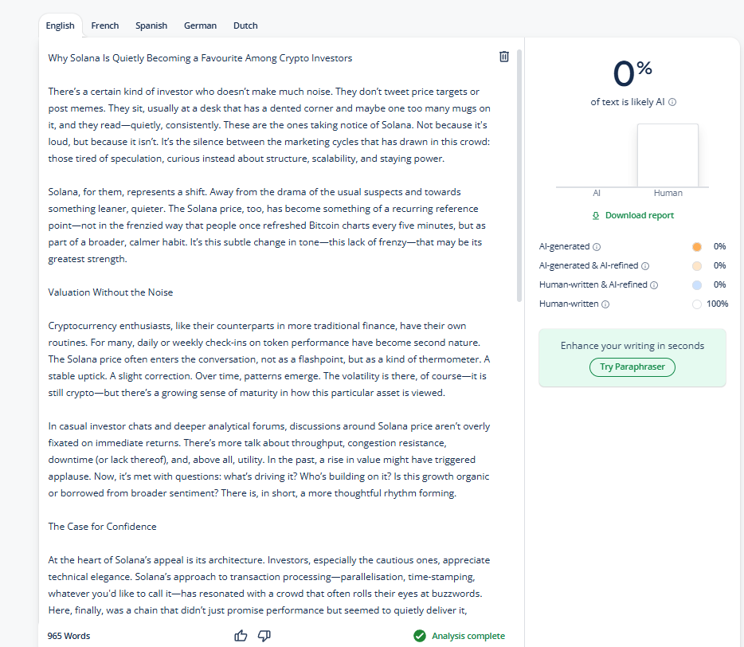There’s a certain kind of investor who doesn’t make much noise. They don’t tweet price targets or post memes. They sit, usually at a desk that has a dented corner and maybe one too many mugs on it, and they read—quietly, consistently. These are the ones taking notice of Solana. Not because it’s loud, but because it isn’t. It’s the silence between the marketing cycles that has drawn in this crowd: those tired of speculation, curious instead about structure, scalability, and staying power.
Solana, for them, represents a shift. Away from the drama of the usual suspects and towards something leaner, quieter. The Solana price, too, has become something of a recurring reference point—not in the frenzied way that people once refreshed Bitcoin charts every five minutes, but as part of a broader, calmer habit. It’s this subtle change in tone—this lack of frenzy—that may be its greatest strength.
Valuation Without the Noise
Cryptocurrency enthusiasts, like their counterparts in more traditional finance, have their own routines. For many, daily or weekly check-ins on token performance have become second nature. The Solana price often enters the conversation, not as a flashpoint, but as a kind of thermometer. A stable uptick. A slight correction. Over time, patterns emerge. The volatility is there, of course—it is still crypto—but there’s a growing sense of maturity in how this particular asset is viewed.
In casual investor chats and deeper analytical forums, discussions around Solana price aren’t overly fixated on immediate returns. There’s more talk about throughput, congestion resistance, downtime (or lack thereof), and, above all, utility. In the past, a rise in value might have triggered applause. Now, it’s met with questions: what’s driving it? Who’s building on it? Is this growth organic or borrowed from broader sentiment? There is, in short, a more thoughtful rhythm forming.
The Case for Confidence
At the heart of Solana’s appeal is its architecture. Investors, especially the cautious ones, appreciate technical elegance. Solana’s approach to transaction processing—parallelisation, time-stamping, whatever you’d like to call it—has resonated with a crowd that often rolls their eyes at buzzwords. Here, finally, was a chain that didn’t just promise performance but seemed to quietly deliver it, week after week.
That isn’t to say it’s immune to criticism. Far from it. But it does handle pressure well, and this has been noticed. Uptime matters. So does developer interest. So does the ability to scale without shouting about it. Solana, it seems, has taken the view that reliability is its best marketing. For investors burned by overpromising roadmaps elsewhere, this quiet consistency is a welcome change.
What Smart Money Looks For
You can often spot the direction of smart capital by what it doesn’t say. Some investment trends arrive with horns and headlines. Others, like this one, seep in. The conversations about Solana tend to happen in the gaps—between meetings, in private newsletters, in the fine print of portfolio rebalancing strategies. This isn’t the retail rush of 2021. It’s something slower, more methodical.
Two qualities tend to guide these choices: speed and sustainability. Not just technical speed (though Solana has that), but speed of development, of integration, of iteration. And sustainability, not just environmental, but financial and operational. Can a project continue to attract talent? Does it make economic sense long-term? Is it surviving not because of sentiment, but because of actual use?
Ecosystem Without Excess
One thing Solana has managed—almost accidentally, perhaps—is to foster an ecosystem that feels proportionate. Some chains balloon too quickly. Projects pile in. Value locks in. It looks impressive, until it doesn’t. Solana’s ecosystem, by contrast, has grown with a certain restraint. There are innovations, certainly, and expansions, but rarely with the frantic air of a land grab. The pace suggests confidence.
The projects choosing Solana now tend to be deliberate. Developers, too, are taking time to understand what it offers. This isn’t a gold rush. It’s closer to a workshop. There’s something almost analogue about it: a sense of building rather than chasing. In a space that often rewards bravado, this culture of focus may well be Solana’s long-term advantage.
Resilience That Doesn’t Announce Itself
Every blockchain project faces its storm. For Solana, it came early and hard—technical faults, outages, criticism. But it didn’t fold. In fact, it improved. Quietly, update by update. That sort of resilience doesn’t get headlines, but it’s what gives serious investors peace of mind. They aren’t looking for perfection; they’re looking for adaptability.
When a system stumbles, the question isn’t why, but what comes next. With Solana, the answer has consistently been: refine, not retreat. It’s this pattern—acknowledge the flaw, fix it, move forward—that has gradually turned tentative holders into long-term believers. Confidence isn’t built with whitepapers; it’s built with response time.
A Growing Conviction
Solana may not be shouting, but the interest around it is getting harder to ignore. What started as cautious optimism has begun to harden into strategy. It’s not about hype anymore. It’s about data. Reliability. Structure. Smart money tends to follow strength in design, and Solana is proving that it has more to offer than many initially assumed.
The next phase won’t be driven by slogans. It’ll be shaped by continued performance, by whether developers stay, by how well the chain supports real-world use cases. So far, the signals are encouraging. Not euphoric, not bombastic—just solid. And in crypto, that’s rare enough to be worth watching.
FAQs
Is Solana still a risky investment?
All cryptocurrencies carry inherent risk due to their volatility, but Solana’s consistent technical performance and growing developer interest have made it more attractive to long-term investors.
How has Solana improved its stability?
Following early network issues, Solana introduced upgrades to its validator system and scheduling mechanism, significantly reducing outages and increasing reliability.
